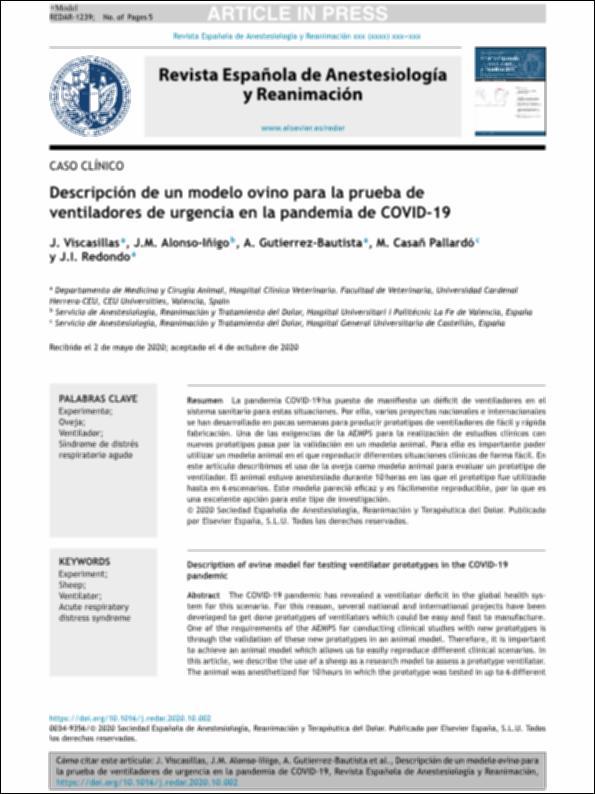Please use this identifier to cite or link to this item:
http://hdl.handle.net/10637/13046Descripción de un modelo ovino para la prueba de ventiladores de urgencia en la pandemia de COVID-19
| Title: | Descripción de un modelo ovino para la prueba de ventiladores de urgencia en la pandemia de COVID-19 |
| Other Titles: | Description of ovine model for testing ventilator prototypes in the COVID-19 pandemic |
| Authors : | Viscasillas Monteagudo, Jaime Alonso Iñigo, José Miguel Gutiérrez Bautista, Álvaro Jesús Casañ Pallardó, Miguel Redondo García, José Ignacio |
| Keywords: | Ovejas - Experimentación biológica y médica.; Artificial respiration.; Respiración artificial.; Sheep - Experiments. |
| Publisher: | Elsevier |
| Citation: | Viscasillas, J., Alonso-Iñigo, J.M., Gutierrez-Bautista, A., Casañ Pallardó, M. & Redondo, J.I. (2020). Descripción de un modelo ovino para la prueba de ventiladores de urgencia en la pandemia de COVID-19. Revista Española de Anestesiología y Reanimación, In Press (23 oct.). DOI: https://doi.org/10.1016/j.redar.2020.10.002 |
| Abstract: | La pandemia COVID-19 ha puesto de manifiesto un déficit de ventiladores en el sistema sanitario para estas situaciones. Por ello, varios proyectos nacionales e internacionales se han desarrollado en pocas semanas para producir prototipos de ventiladores de fácil y rápida fabricación. Una de las exigencias de la AEMPS para la realización de estudios clínicos con nuevos prototipos pasa por la validación en un modelo animal. Para ello es importante poder utilizar un modelo animal en el que reproducir diferentes situaciones clínicas de forma fácil. En este artículo describimos el uso de la oveja como modelo animal para evaluar un prototipo de ventilador. El animal estuvo anestesiado durante 10 horas en las que el prototipo fue utilizado hasta en 6 escenarios. Este modelo pareció eficaz y es fácilmente reproducible, por lo que es una excelente opción para este tipo de investigación. / The COVID-19 pandemic has revealed a ventilator deficit in the global health system for this scenario. For this reason, several national and international projects have been developed to get done prototypes of ventilators which could be easy and fast to manufacture. One of the requirements of the AEMPS for conducting clinical studies with new prototypes is through the validation of these new prototypes in an animal model. Therefore, it is important to achieve an animal model which allows us to easily reproduce different clinical scenarios. In this article, we describe the use of a sheep as a research model to assess a prototype ventilator. The animal was anesthetized for 10 hours in which the prototype was tested in up to 6 different scenarios. This model is effective and easy to reproduce, making it an excellent choice for this kind of research. |
| Description: | Este artículo se encuentra disponible en la siguiente URL: https://www.sciencedirect.com/science/article/abs/pii/S0034935620302632?via%3Dihub This is the peer reviewed version of the following article: Viscasillas, J., Alonso-Iñigo, J.M., Gutiérrez-Bautista, A., Casañ-Pallardó, M. & Redondo, J.I. (2020). Descripción de un modelo ovino para la prueba de ventiladores de urgencia en la pandemia de COVID-19, In Press (23 oct.), which has been published in final form at https://doi.org/10.1016/j.redar.2020.10.002 Este es el post-print del siguiente artículo: Viscasillas, J., Alonso-Iñigo, J.M., Gutiérrez-Bautista, A., Casañ-Pallardó, M. & Redondo, J.I. (2020). Descripción de un modelo ovino para la prueba de ventiladores de urgencia en la pandemia de COVID-19, In Press (23 oct.), que se ha publicado de forma definitiva en https://doi.org/10.1016/j.redar.2020.10.002 |
| URI: | http://hdl.handle.net/10637/13046 |
| Rights : | http://creativecommons.org/licenses/by-nc-nd/4.0/deed.es |
| ISSN: | 0034-9356 (Electrónico) |
| Issue Date: | 23-Oct-2020 |
| Center : | Universidad Cardenal Herrera-CEU |
| Appears in Collections: | Dpto. Medicina y Cirugía Animal |
Items in DSpace are protected by copyright, with all rights reserved, unless otherwise indicated.


